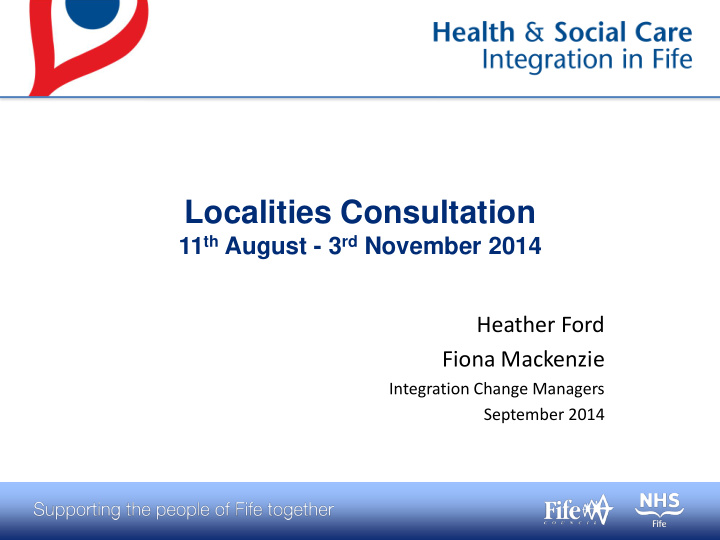



Localities Consultation 11 th August - 3 rd November 2014 Heather Ford Fiona Mackenzie Integration Change Managers September 2014
Strategic Context • Christie Report (2011) new relationship between citizens and public services in which communities and individuals are empowered to take a real stake in the planning and delivery of public services in a way which best meets local needs and priorities. • “All Hands on Deck”, published in July 2013 highlights that localities are the engine room of integration, centred on people and the communities they live in. • The Public Bodies (Joint Working) Scotland Act 2014 requires that Local Authority should be divided into two or more localities.
What is Community Planning? • Is a process which helps public agencies to work together with the community, to plan and deliver better services which make a real difference to peoples lives. • Partners include health, housing, social work, voluntary sector, transport, fire, police, enterprise, further education and many other partners including Fife Businesses are closely involved.
Community planning… • A commitment from organisations to work together, and not apart, to provide public services. • The aims are to make sure people and communities are genuinely engaged in the decisions made on public services which affect them.
How did we approach this? • Identified planning principles • Identified possible options based on what we know • Considered available Data • Conclusions for consultation
Fife Locality Planning Principles • Impact on those who use the service • Meeting local priorities • Reflect variation • Support integrated models • Community involvement • Benefits to the local area
Options for Localities 1. 7, based on the community planning boundaries(North East Fife, Glenrothes, Kirkcaldy, Levenmouth, Dunfermline South West Fife and Cowdenbeath) 2. 3, based on the CHPs ( Dunfermline and West Fife, Kirkcaldy and Levenmouth and Glenrothes/ North East Fife) 3. 3, based on historical planning boundaries ( East, West and Central) 4. 2, based on current social work structure( East and West)
Option 1 7 localities based on current community planning areas
Option 2 3 localities based on CHP boundaries
Option 3 3 localities based on historical planning boundaries
Option 4 2 localities based on current Social Work Structure
Population distribution >65s Data Option 1 Option 2 Option 3 Option 4 Populations NE- 22% KL – 27% Not available West 52% >65s LM – 12% GNEF – 35% but would be East 48% Kirk – 17% DWF – 36% more evenly Glen – 13% distributed C’beath 11% Dun – 12% SW Fife 13%
Activity Data Option 1 Option 2 Option 3 Option 4 SW contacts NE- 1125 KL – 3600 Not available West-6000 LM – 1650 GNEF – 3100 but would be East-4700 Kirk – 2175 more evenly DWF - 4000 Glen – 1750 distributed C’beath 1425 Dun – 1200 SW Fife 1375 Home care NE- 700 KL- 1250 Not available West - 2100 LM – 500 GNEF -1350 but would be East – 1900 client Kirk – 710 DWF - 1400 more evenly numbers Glen – 615 distributed C’beath 440 Dun – 490 SW Fife - 450
GP registration living outside locality Data Option 1 Option 2 Option 3 Option 4 GP ( % 5% 0.8% 2.3% 0.7% patients living outside the locality*
The rationale for decision making in terms of locality arrangements • would be based on which option best meets the agreed planning principles.
Fife Locality Planning Principles • Impact on those who use the service • Meeting local priorities • Reflect variation • Support integrated models • Community involvement • Benefits to the local area
Summary of strengths and weaknesses Options Strengths Weaknesses 1 Closer alignment to communities Some services may not be able to be fully and hard to reach groups, reflecting integrated and discreet to the local area. local needs. Highest level of patients living outside the locality 2 Already exists and is currently Further removed from communities, but aligned with GP practices, with low reflects collections of several levels of patients living outside communities. locality 3 Difficult to identify due to lack of High levels of patients living outside the locality and poor alignment with local alignment with other structures community planning areas. 4 Lowest level of patients living out Significantly removed from local communities, so would require sub with the locality. division.
Analysis • The 7 locality option, based on community planning areas, most closely met the criteria. • Appreciating that even these localities have communities within each, and locality working would need to reflect this. • The 7 locality option is therefore proposed.
Benefits • Strengthening links with GP’s and other groups working in the localities. • Building stronger networks with local groups charities, voluntary and independent orgs. • Combining knowledge and expertise to take account differing needs now and in the future.
Benefits continued • Consistent provision of core services across all localities with local flexibility to plan in a way that reflect local need. • Using established community planning structures. • Meets Scottish Government planning principles.
Common questions • Is this about management structures? – no, it is about planning and involvement of local people. • Why do this? – by involving local people, and the wider system e.g. housing and other community planning partners in co -producing solutions and service models, we can better meet needs and reduce inequalities.
Getting involved – we want your views • www.fifedirect.org.uk/integration • Call 03451 555555 ext 444230 • Consultation ends 3 rd Nov 2014 • Formal report will be submitted to the Shadow Integrated Joint Board on 27 th November 2014.
Recommend
More recommend